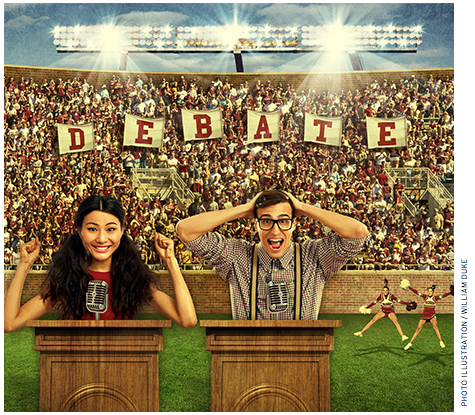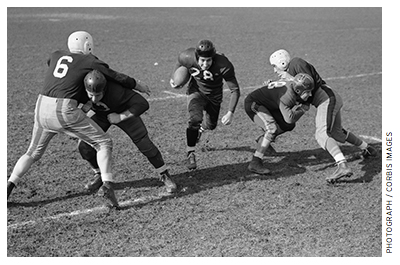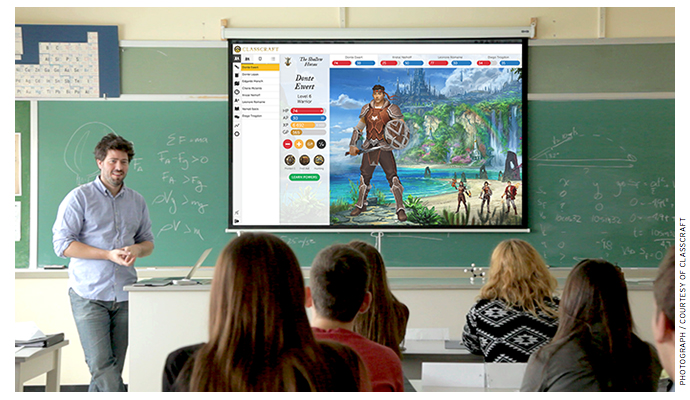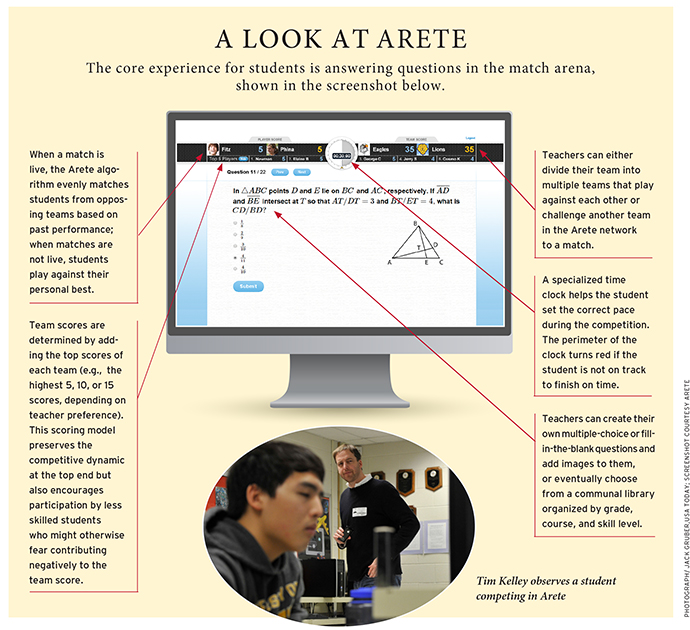This article is part of a new Education Next series commemorating the 50th anniversary of James S. Coleman’s groundbreaking report, “Equality of Educational Opportunity.” The full series will appear in the Spring 2016 issue of Education Next.
 In 1959, six years before he authored the study that would remake America’s segregated public schools, James S. Coleman found himself face to face with a very different foe: the inscrutable desires, evolving tastes, and secret motivations of the post–World War II American teenager.
In 1959, six years before he authored the study that would remake America’s segregated public schools, James S. Coleman found himself face to face with a very different foe: the inscrutable desires, evolving tastes, and secret motivations of the post–World War II American teenager.
At the time, Coleman was head of Johns Hopkins University’s Department of Social Relations (later renamed the Department of Sociology). He had just spent two years studying the “climate of values” at several midwestern high schools, interviewing students about their academic lives, their social lives, school culture, and their rapidly evolving teen culture. Deep within the data, he found what he considered the root of the underachievement crisis in American high schools: a management structure that misunderstood teenagers and fundamentally misused student incentives.
For more than 50 years, Coleman’s findings in this study have been overshadowed by those of the Coleman Report. But scholars and educators would do well to revisit Coleman’s earlier focus on student culture and motivations if we’re to understand, in his words, “why and for whom educational institutions fail.”
That Coleman in 1959 saw a direct link between teen culture and high school achievement is significant. Though the first public high school opened in Boston in 1821, for more than a hundred years, the majority of American teens were otherwise engaged. Most didn’t hold a high school diploma until 1940. The byproduct of more universal schooling—or perhaps its main product—was the American teenager, “a New Deal project” much like the Hoover Dam, wrote cultural critic Thomas Hine. Actually, Hine noted, the word “teenager” first appeared in a 1941 Popular Science article. Compulsory education gave rise, inevitably, to mid-20th-century teen culture, and in quick succession, to nearly every cultural artifact we now associate with teens, most of them tied to breakthroughs in technology. Cheaper automobiles, color printing, and better amplification brought us car culture, comic books, and pop music—who can imagine a crooning Frank Sinatra screaming his way through the 1942 Paramount sessions? A generation later, another technological trio—birth control pills, synthesized LSD, and multitrack recording—brought us sex, drugs, and rock-and-roll.
Coleman hadn’t much cared for high school himself. Born in Indiana in 1926, he attended high school in Greenhills, Ohio, then in Louisville, where each year two rival schools fought bitterly on the football field. The teams’ annual face-off, played on Thanksgiving Day, “flavored the whole school year,” he later recalled. Coleman joined the team and would later write that the “boys who counted in the school were the first-string varsity football players.” Other than football, nearly nothing held his interest. Years later, he’d write of hitchhiking to football practice one day, thinking to himself: “If only they would not destroy in us the interest with which we came to school, I would ask for nothing more.”
Coleman ended up at Columbia University, where a chance dinner conversation with friends near the end of his tenure there got him thinking about how the culture of one’s high school can have a life-changing impact—actually, it was that conversation that got him studying schools in the first place. When he began interviewing high school students a few years later, he discovered that little had changed. In schools from the inner city to the most privileged suburbs, teens were intensely social, spending most of their free time playing sports and hanging out. “Adults often forget how ‘person-oriented’ children are,” he wrote in 1959 in the Harvard Educational Review. “They have not yet moved into the world of cold impersonality in which many adults live.”
The paradox of modern schooling after World War II, he found, was that just as our complex industrial society made formal education more important, adolescent culture was shifting teens’ attention away from education, prompting adolescents to squeeze out “maximum rewards for minimal effort.” One girl told him what it really took to be part of “the leading crowd” at her high school: “Don’t be too smart. Flirt with boys. Be cooperative on dates.”
Coleman found that in many schools, athletics ruled. More than 40 percent of boys, for instance, wanted to be remembered in school as a “star athlete,” but fewer than 30 percent favored the epithet “brilliant student,” despite the fact that, as Coleman observed, school was “an institution explicitly designed to train students, not athletes.”
Misbegotten Competition
Students understood that the reward system in high school was deeply unfair.
Because of its heavy reliance on academic letter grades, the typical American high school had created a kind of free market in which every student was competing against every other student for rank. Grades, he found, were almost completely relative—when one student achieved more, it “not only raise[d] his position, but in effect lower[ed] the position of others.”
Like factory workers or prison inmates, to which Coleman directly compared them, he found that most high school students in the 1950s had responded to school’s demands by “holding down effort to a level which can be maintained by all.” The institutions may be different, he wrote, “but the demands are there, and the students develop a collective response to these demands.” It was, Coleman suggested, a rational response to a system whose rewards sat on a bell curve. Students were protecting themselves from extra work by ostracizing high achievers, “constraining the fast minority,” and holding down the achievements of those who were above average, “so that the school’s demands will be at a level easily maintained by the majority.”
A few academically oriented, highly competitive “isolates” might prosper under this system, he found, but even the gifted high achievers, set apart with “special tasks,” usually found themselves unhappily separated from their peers. And the effort to serve gifted children, he wrote, “at its best probably misses far more potential scientists and scholars than it finds.”

The result of this misbegotten competition, even in the best suburban schools, was intense social pressure to minimize, not maximize, studying. Low achievement, in other words, wasn’t a bug in the high school system. It was an essential feature.
On the other hand, students didn’t think twice about honoring athletes. Coleman theorized that because most athletic events pit school against school, the achievements of star athletes bring prestige to the entire school, which benefits everyone. A student spending her lunch hour studying “is regarded as someone a little odd, or different, or queer,” he wrote. But the basketball player who shoots baskets at lunch “is watched with interest and admiration, not with derision.”
In high school athletics, Coleman wrote, “there is no epithet comparable to curve-raiser, there is no ostracism for too-intense effort or for outstanding achievement. Quite to the contrary, the outstanding athlete is the ‘star,’ extra effort is applauded by one’s fellows, and the informal group rewards are for positive achievement, rather than for restraint of effort.” The athlete’s achievements, he wrote, “give a lift to the community as a whole, and the community encourages his efforts.”
So Coleman challenged educators to rethink how they viewed competition.
Writing two years later in his 1961 book The Adolescent Society, he noted that educators had long been suspicious of academic competition, but that they unwittingly used it every day when handing out letter grades. The problem, he said, was that the competition in most classrooms was interpersonal. Shift the emphasis—make it interscholastic, that is, school versus school—and the suspicion gives way to celebration.
“When a boy or girl is competing, not merely for himself, but as a representative of others who surround him, then they support his efforts, acclaim his successes, console his failures,” Coleman wrote. “His psychological environment is supportive rather than antagonistic, is at one with his efforts rather than opposed to them. It matters little that there are others, members of other social communities, who oppose him and would discourage his efforts, for those who are important to him give support to his efforts.”
Coleman proposed that schools should replace the competition for grades with interscholastic academic games, “systematically organized competitions, tournaments and meets in all activities,” from math and English to home economics and industrial arts. These competitions, he predicted, would get both students and the general public more focused on academics and ensure all students a better education. It wouldn’t be easy, he predicted: schools would need “considerable inventiveness” to come up with the right vehicles for competition. But they already had a few good models, including math and debate competitions, as well as drama and music contests. He noted that the RAND Corporation and MIT had already established “political gaming” contests with great success.
In the early 1960s, Coleman developed six games and tested them in Baltimore schools. Teachers, he would later write, “came to share our enthusiasm for this reconstruction of the learning environment.” But he admitted that his vision was “not realized,” even though a handful of fellow researchers at Hopkins and elsewhere piloted academic games with great success.
A Research “Detour”
Actually, Coleman was deep into his work on games when he got the call to pursue the wide-ranging examination of school conditions and achievement that would eventually become “Equality of Educational Opportunity,” or EEO, more popularly known as the Coleman Report. He later recalled that he saw working on the massive EEO survey as “a detour in my research direction,” though he understood its importance.
The report’s results, released in 1966, popularized the idea that a student’s home life and family background mattered more than what happened at school. Most significantly, Coleman asserted that disadvantaged black students would do better academically if they attended schools in which the majority of their classmates were white. The Coleman Report would change American schooling forever, providing the theoretical basis for court-ordered busing plans, which gave rise to widespread, unintended “white flight” to suburbs in the 1960s and 1970s. In a follow-up study nearly a decade after the release of EEO, Coleman concluded that busing had become an empty exercise.
Even as school systems redrew their boundaries, fired black teachers and principals, and tore up foundational enrollment structures to comply with desegregation orders, they largely ignored Coleman’s earlier research on motivation and academic achievement, which found that competition “has a magic ability to create a strong group goal.” Looking back 25 years later, Coleman himself would note that the Coleman Report’s focus on administrative issues had largely ignored what he had long considered key: the necessity of talking to students about the social systems of schools and how they actually felt, day to day, going to school. As a result, he concluded, the report “may have missed the most important differences between the school environments in which black and white children found themselves.” Had his seminal work focused on both the administrative problems and the social systems of school, Coleman later wrote, “our knowledge of how to overcome problems of racial segregation would be far more advanced than it is.” The result, he said, might have been more sturdily integrated schools without the racial backlash.
The irony of Coleman’s earlier findings is that, more than a half century later, students are, to no one’s surprise, still “person-oriented,” focusing more closely on their peers than on nearly anything adults ask them to consider. And schools still routinely use sports, games, social clubs, and band competitions, among other devices, to get students excited about coming to school. In fact, these activities are often the only ones that keep kids there long enough to graduate. Over the past few decades, many schools have embraced national and even international academic competitions such as the National Geographic Bee, the Scripps National Spelling Bee, MATHCOUNTS, National History Day, and Odyssey of the Mind, among others. But even though several of these competitions boast thousands or even millions of participants—the spelling bee claims that upward of 10 million children participate each year—schools have rarely used academic competition to improve instruction for more than just a few top students, in essence replicating the same old academic bell curve. Coleman would not be pleased.

Remaking School Culture
The need for such a new culture is huge: Indiana University’s High School Survey of Student Engagement has found, for instance, that 65 percent of students report being bored “at least every day in class.” Sixteen percent—nearly one in six students—are bored in every class.
Shawn Young, a 32-year-old Canadian physics teacher, has created a peer-driven classroom learning and management system, dubbed Classcraft, that resembles a low-tech, sword-and-sorcery video game. In it, students work in teams to meet the basic demands of school—showing up on time, working diligently, completing homework, behaving well in class, and encouraging each other to do the same—to earn “experience” and “health” points. These points help a small group, or “guild,” of classmates prosper in the game. The system, Young said, essentially replaces letter grades.
Echoing Coleman, Young told me most adults don’t understand how strongly teenagers feel the need to belong to a group, fighting together for a common cause. In that sense, he said, letter or percentage grades “are horrible as general motivators,” especially for struggling students. Going from a D to a B in a class is such a long-term endeavor that most feel it’s a lost cause. “If you’ve had Ds for five years, you’re convinced you’re a D student and you’ll always have Ds, because even if you do more work it’s not going to have an immediate repercussion.” He hopes Classcraft will help break the cycle. As students move up through the levels of the game, they actually pay less attention to grades and more attention to keeping their guild teammates “alive” and “healthy.”
There are many other initiatives that play upon Coleman’s basic thesis. In 2013, visiting Thomas Jefferson High School for Science and Technology in Alexandria, Virginia, affectionately known as “TJ,” I watched as two members of the math team sat at computer terminals and worked through a set of high-level math problems. They were competing against a group of four other students who were sitting, at that moment, in a similar room in a similar high school 600 miles away, in the Indianapolis suburb of Carmel, Indiana. The opponents were simultaneously attacking the same set of problems. Each time someone solved one correctly, the digital score counter moved on all six screens.
Math Madness
If math ever becomes a spectator sport—and stranger things have happened—we can look back on these problem sets and the massive tournament they eventually spawned and thank Tim Kelley. He is the man who dreamed up Arete (originally named Interstellar), the curious piece of software that he hopes will change how students feel not just about math but about academics of nearly every sort. Kelley has spent most of the past six years cold-calling school administrators, flying around the United States, and figuring out how to build NCAA-style bracket competitions in academic subjects. In Kelley’s dream, Arete will pit class against class, school against school, and, someday, nation against nation.
A Chicago native and perpetual graduate student—he holds degrees in law and business, among others—Kelley got the inspiration for Arete while volunteering to help the rowing team train at his old high school. He watched as rowers took a routine but grueling endurance test, and felt that the atmosphere was “electric.” Though their scores didn’t mean anything in the long run, the rowers were obsessed with the task at hand, pushing to achieve their personal best. Kelley began to wonder how one might replicate that fighting spirit in the classroom. He soon imagined a computer application that would use students’ day-to-day results to match them up with comparably skilled contestants in head-to-head academic competition—in everything from classroom pickup games to bleacher-filling, live-broadcast amphitheater tournaments.
In September 2012, Kelley called Steve Dunbar, director of the American Mathematics Competitions, or AMC, an elite program sponsored by the nonprofit Mathematical Association of America, with the idea of a competition based on AMC problems. The competition, founded in 1950, enrolls about 400,000 students, but it still uses pencil and paper and can take weeks to score. Dunbar had actually been searching for a way to bring AMC into the 21st century, and as soon as Kelley described his vision, Dunbar knew that this was what he’d been looking for. In two months, Kelley had a prototype. In five months, he and Dunbar had selected 16 high schools to field-test the software. By February 2013, the first trials began.
To those who blanch at Coleman’s vision of making academics a spectator sport, Kelley says the focus of Arete, as with the rowers’ fitness test, is on helping students achieve “personal best” milestones, a strategy that most schools rarely use. “Once kids see they’re getting better, it just perpetuates improvement,” he said. When I met Kelley, he was working on a tool that would allow spectators to view Arete matches live online. He said he hoped that would “bring enough glory to the math department, or enough glory to the math students, that everybody else says, ‘I’d like to try this, too.’”
In September 2013, after the pilot testing, 468 schools showed up for the beginning of the first Arete fall competition, and Kelley soon had 10,000 kids on the platform weekly. By November, he had arranged the highest-scoring 384 teams into six 64-team brackets. Two weeks before Christmas, the Final Four teams in each of the six divisions fought for their division’s title. In the highest division, TJ actually made it to the Final Four, but was outscored by the Academy for the Advancement of Science and Technology in Hackensack, New Jersey. Hackensack lost in the finals to San Jose’s Harker School. The following September, nearly 600 schools and 15,000 students showed up to play, paying a modest fee of between $120 and $195 per school, for access to the platform for the entire season.
In October 2015, Kelley received a grant of nearly $150,000 from the National Science Foundation to further develop his project. Soon, students will be able to arrange matches on their own. What’s more, hundreds of thousands of 6th- to 12th-grade students will be able to compete simultaneously in a challenge that decides a national and eventually a worldwide champion. After implementing that feature, Kelley wants to expand the same tournament model to other school subjects and grades.
AMC’s Dunbar hopes that Arete will ultimately bring high-level math to a larger audience—the traditional AMC is focused on just the top 10 percent of students in the top 10 percent of schools. “One of the things that I do, one of the things that gets me up and here into the office every day, is that I want to get more good math in front of more kids, more often, in as many ways as I possibly can,” he said. International competitions pitting our best students against the best in the world could be thrilling. “If you look at the top level of competition, the United States is as strong as any other country in the world,” he said. “It would be good and it would be competitive. It would be exciting.”
Coleman would be pleased.
Greg Toppo is USA Today’s national education writer and the author of The Game Believes in You: How Digital Play Can Make Our Kids Smarter. Portions of this essay appeared in the book.
This article appeared in the Spring 2016 issue of Education Next. Suggested citation format:
Toppo, G. (2016). Game Plan for Learning: Building on Coleman’s early theories, new academic competitions motivate students to achieve. Education Next, 16(2), 38-45.



